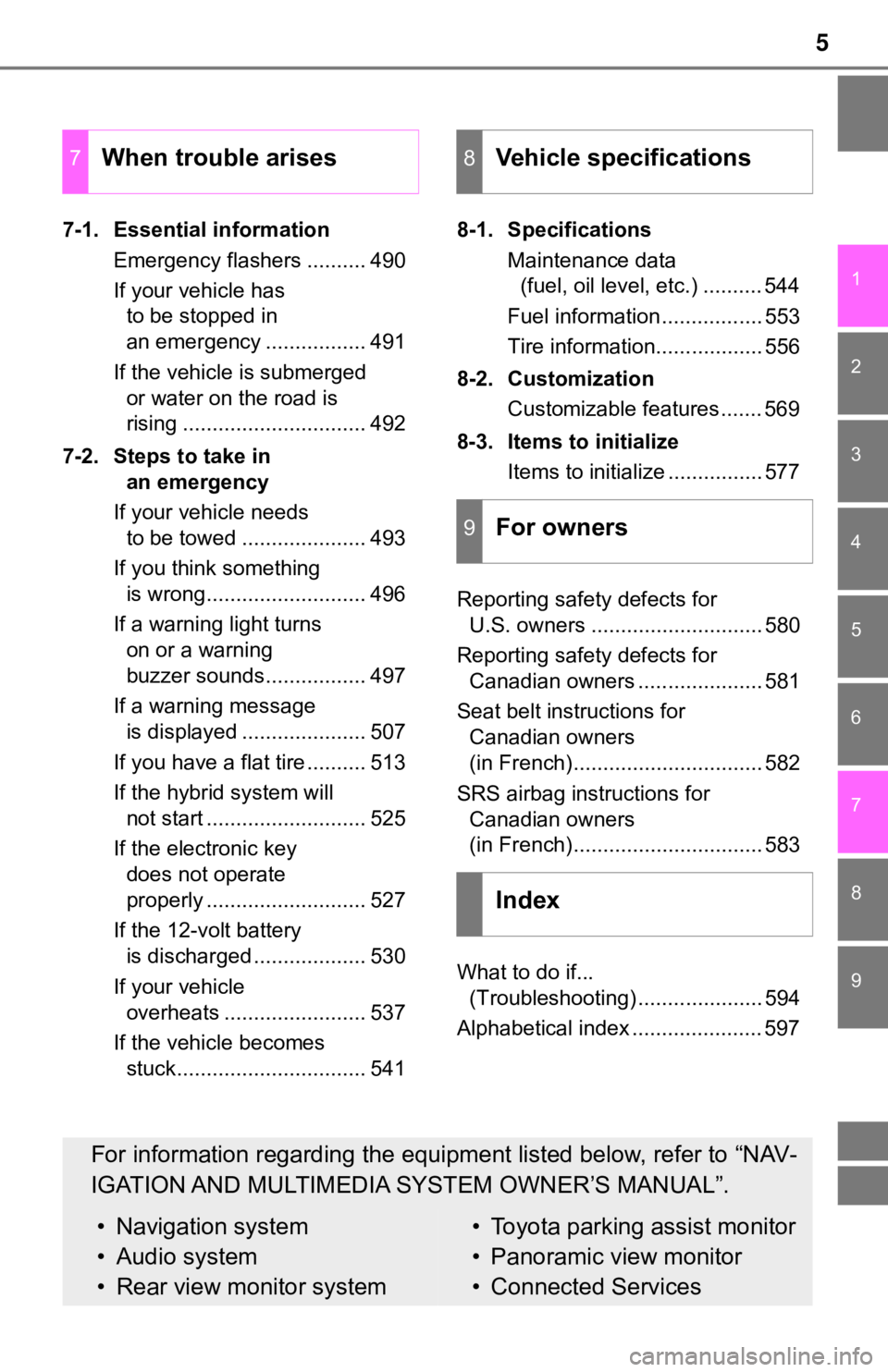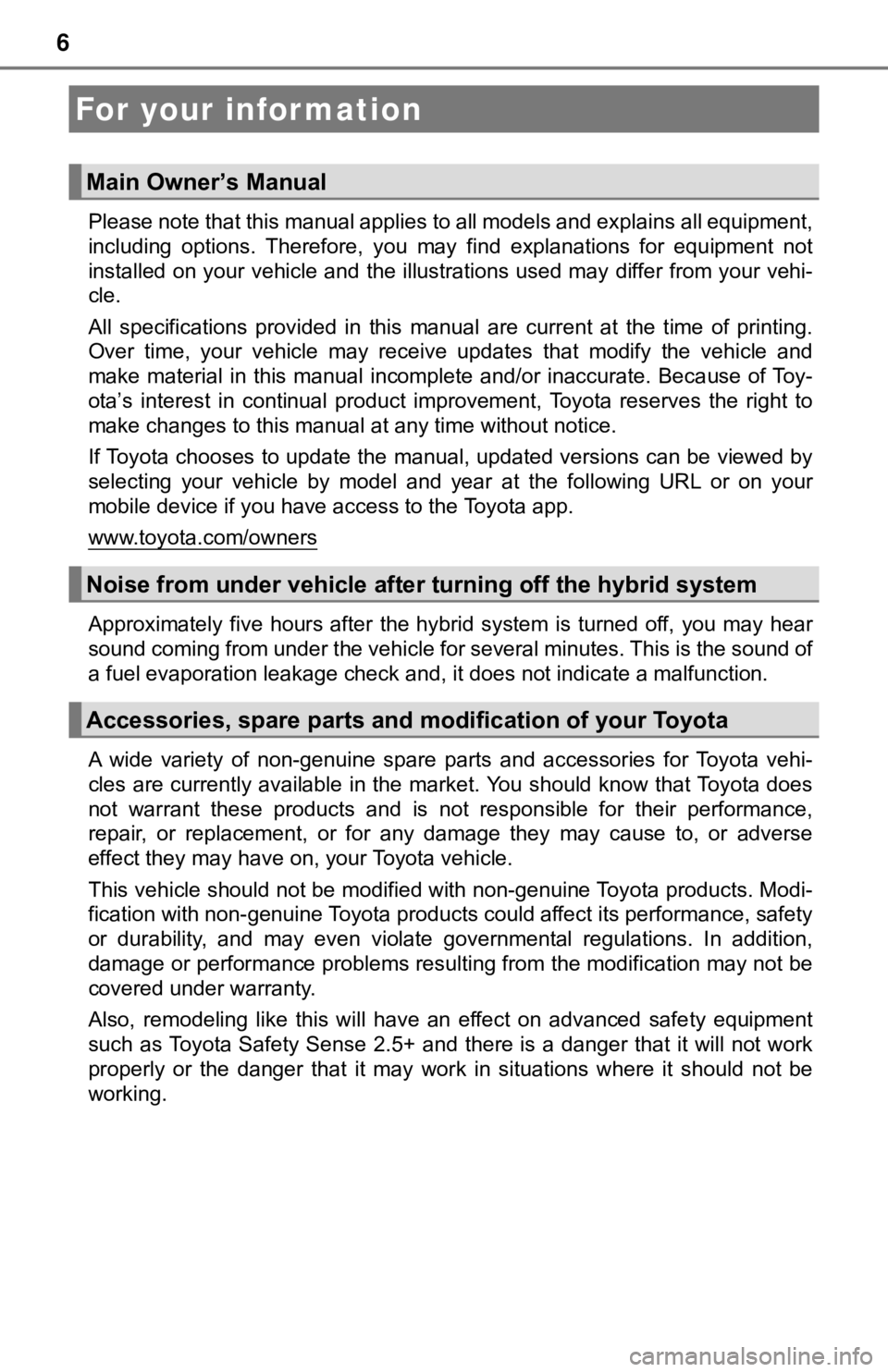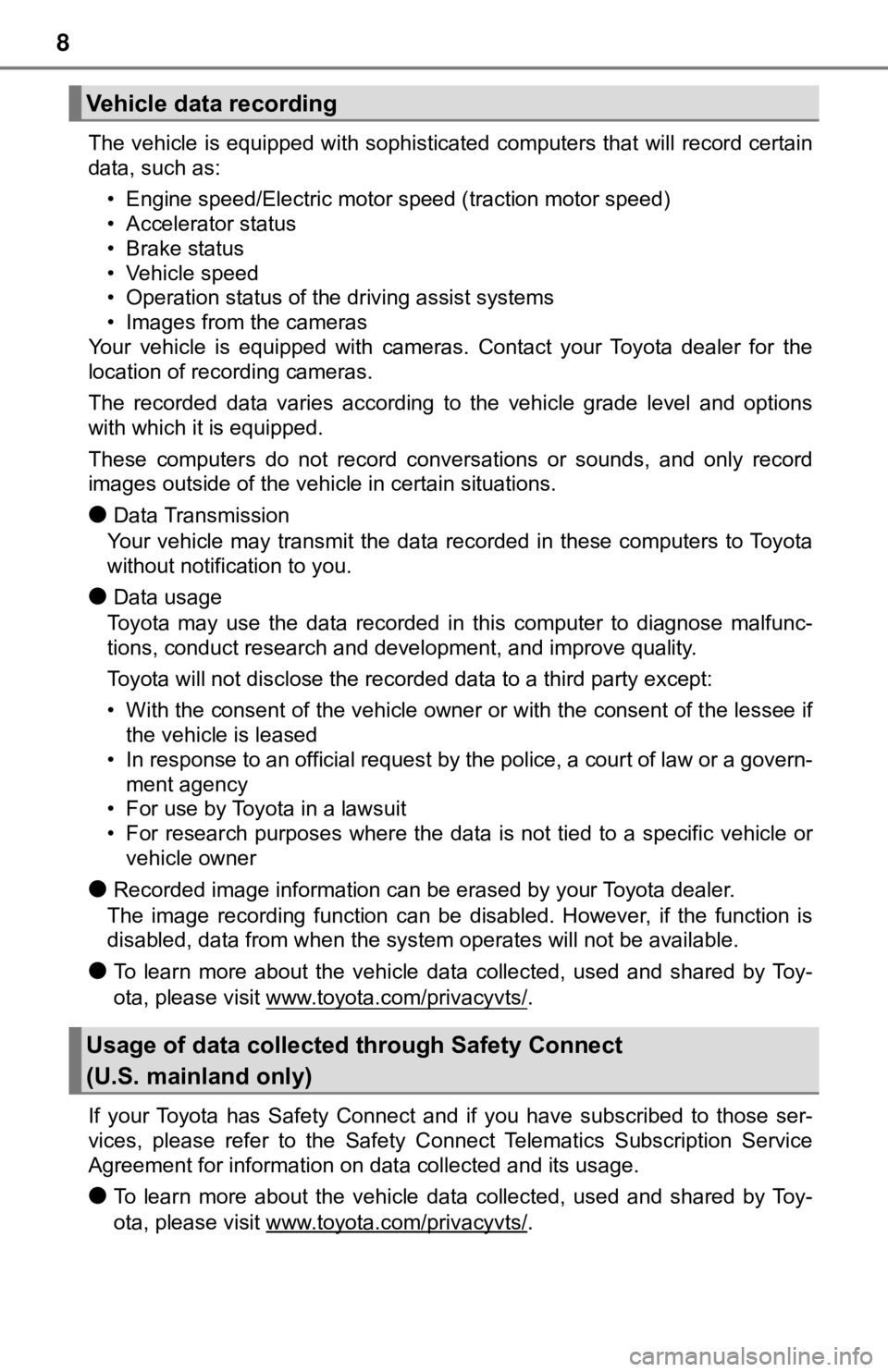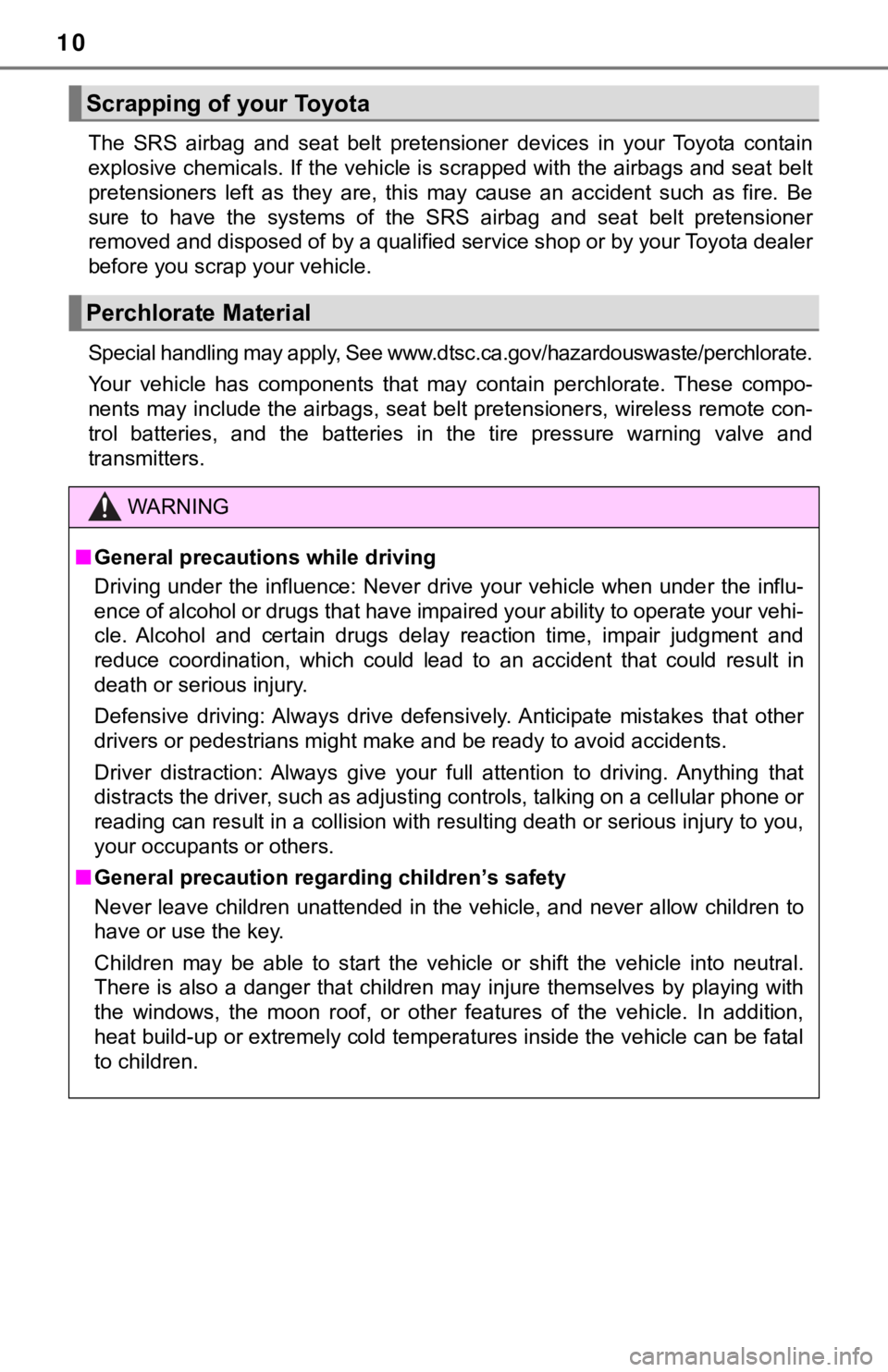TOYOTA CAMRY HYBRID 2022 Owners Manual
Manufacturer: TOYOTA, Model Year: 2022, Model line: CAMRY HYBRID, Model: TOYOTA CAMRY HYBRID 2022Pages: 624, PDF Size: 13.76 MB
Page 1 of 624

Pictorial indexSearch by illustration
1For safety
and securityMake sure to read through them
2Instrument
clusterHow to read the gauges and meters, the variety of
warning lights and indicators, etc.
3
Operation of
each
componentOpening and closing the doors and windows,
adjustment before driving, etc.
4DrivingOperations and advice which are necessary for
driving
5Interior featuresUsage of the interior features, etc.
6Maintenance
and careCaring for your vehicle and maintenance
procedures
7When trouble
arisesWhat to do in case of malfunction or emergency
8Vehicle
specificationsVehicle specifications, customizable features, etc.
9For ownersReporting safety defects for U.S. owners, and seat
belt and SRS airbag instructions for Canadian
owners
IndexSearch by symptom
Search alphabetically
Page 2 of 624

TABLE OF CONTENTS2
For your information....................... 6
Reading this manual .................... 12
How to search .............................. 13
Pictorial index .............................. 14
1-1. For safe use
Before driving ...................... 24
For safe driving ................... 26
Seat belts ............................ 28
SRS airbags ........................ 34
Front passenger occupant
classification system ......... 47
Exhaust gas precautions ..... 52
1-2. Child safety
Riding with children ............. 53
Child restraint systems ........ 54
1-3. Emergency assistance
Safety Connect.................... 73
1-4. Hybrid system
Hybrid system features ....... 78
Hybrid system
precautions ....................... 82
1-5. Theft deterrent system
Immobilizer system ............. 89
Alarm ................................... 902. Instrument cluster
Warning lights and
indicators ........................... 94
Gauges and meters ........... 100
Multi-information display
(4.2-inch display) ............. 104
Multi-information display
(7-inch display) ................ 117
Head-up display................. 136
Energy monitor/
consumption screen ........ 142
3-1. Key information
Keys................................... 150
3-2. Opening, closing and
locking the doors
Doors ................................. 154
Trunk ................................. 160
Smart key system .............. 164
3-3. Adjusting the seats
Front seats......................... 171
Rear seats ......................... 173
Head restraints .................. 175
3-4. Adjusting the steering
wheel and mirrors
Steering wheel ................... 177
Inside rear view mirror ....... 179
Outside rear view
mirrors ............................. 181
3-5. Opening and closing
the windows
Power windows.................. 183
Moon roof .......................... 186
1For safety and security
2Instrument cluster
3Operation of each
component
Page 3 of 624

3
1
9 7 6
5
4
3
2
8
4-1. Before driving
Driving the vehicle ............. 192
Cargo and luggage............ 200
Vehicle load limits ............. 203
Trailer towing..................... 204
Dinghy towing.................... 205
4-2. Driving procedures
Power (ignition) switch ...... 206
EV drive mode................... 213
Hybrid transmission........... 216
Turn signal lever................ 222
Parking brake .................... 223
Brake Hold ........................ 227
4-3. Operating the lights
and wipers
Headlight switch ................ 230
AHB (Automatic High
Beam) ............................. 234
Windshield wipers and
washer ............................ 238
4-4. Refueling
Opening the fuel tank
cap .................................. 2424-5. Using the driving
support systems
Toyota Safety
Sense 2.5+ ...................... 246
PCS (Pre-Collision
System) ........................... 252
LTA (Lane Tracing
Assist).............................. 267
RSA (Road Sign Assist) .... 282
Dynamic radar cruise
control with full-speed
range ............................... 287
Driving assist systems ....... 303
BSM (Blind Spot
Monitor) ........................... 310
• BSM function ................. 313
Intuitive parking assist ....... 317
RCTA (Rear Cross Traffic
Alert) ................................ 326
• RCTA function ............... 328
RCD (Rear Camera
Detection) ........................ 335
PKSB (Parking Support
Brake) .............................. 340
Parking Support Brake
function (static objects).... 348
Parking Support Brake
function (rear-crossing
vehicles) .......................... 352
Driving mode select
switches........................... 355
4-6. Driving tips
Hybrid vehicle driving
tips ................................... 357
Winter driving tips .............. 360
4Driving
Page 4 of 624

TABLE OF CONTENTS4
5-1. Using the air conditioning
system and defogger
Automatic air conditioning
system............................. 366
Heated steering wheel/
seat heaters/
seat ventilators ................ 375
5-2. Using the interior lights
Interior lights list ................ 378
• Interior lights ................. 379
• Personal lights .............. 380
5-3. Using the storage
features
List of storage features...... 381
• Glove box...................... 382
• Console box .................. 382
• Coin holder ................... 382
• Bottle holders ................ 383
• Cup holders .................. 384
• Auxiliary boxes.............. 385
• Open tray ...................... 386
Trunk features ................... 387
5-4. Other interior features
Other interior features ....... 388
• Sun visors ..................... 388
• Vanity mirrors................ 388
• Power outlet .................. 389
• USB charging ports....... 390
• Wireless charger ........... 392
• Armrest ......................... 401
• Assist grips ................... 401
• Coat hooks.................... 402
Garage door opener .......... 4036-1. Maintenance and care
Cleaning and protecting
the vehicle exterior .......... 412
Cleaning and protecting
the vehicle interior ........... 416
6-2. Maintenance
Maintenance
requirements ................... 419
General maintenance ........ 422
Emission inspection and
maintenance (I/M)
programs ......................... 426
6-3. Do-it-yourself
maintenance
Do-it-yourself service
precautions ...................... 427
Hood .................................. 429
Positioning a floor jack....... 431
Engine compartment ......... 432
12-volt battery .................... 440
Tires................................... 444
Tire inflation pressure ........ 458
Wheels............................... 461
Air conditioning filter .......... 463
Cleaning the hybrid battery
(traction battery) air
intake vent and filter ........ 465
Electronic key battery ........ 470
Checking and replacing
fuses ................................ 473
Light bulbs ......................... 476
5Interior features6Maintenance and care
Page 5 of 624

5
1
9 7 6
5
4
3
2
8
7-1. Essential information
Emergency flashers .......... 490
If your vehicle has
to be stopped in
an emergency ................. 491
If the vehicle is submerged
or water on the road is
rising ............................... 492
7-2. Steps to take in
an emergency
If your vehicle needs
to be towed ..................... 493
If you think something
is wrong........................... 496
If a warning light turns
on or a warning
buzzer sounds................. 497
If a warning message
is displayed ..................... 507
If you have a flat tire .......... 513
If the hybrid system will
not start ........................... 525
If the electronic key
does not operate
properly ........................... 527
If the 12-volt battery
is discharged ................... 530
If your vehicle
overheats ........................ 537
If the vehicle becomes
stuck................................ 5418-1. Specifications
Maintenance data
(fuel, oil level, etc.) .......... 544
Fuel information ................. 553
Tire information.................. 556
8-2. Customization
Customizable features ....... 569
8-3. Items to initialize
Items to initialize ................ 577
Reporting safety defects for
U.S. owners ............................. 580
Reporting safety defects for
Canadian owners ..................... 581
Seat belt instructions for
Canadian owners
(in French)................................ 582
SRS airbag instructions for
Canadian owners
(in French)................................ 583
What to do if...
(Troubleshooting) ..................... 594
Alphabetical index ...................... 597
7When trouble arises8Vehicle specifications
9For owners
Index
For information regarding the equipment listed below, refer to “NAV-
IGATION AND MULTIMEDIA SYSTEM OWNER’S MANUAL”.
• Navigation system
• Audio system
• Rear view monitor system• Toyota parking assist monitor
• Panoramic view monitor
• Connected Services
Page 6 of 624

6
Please note that this manual applies to all models and explains all equipment,
including options. Therefore, you may find explanations for equipment not
installed on your vehicle and the illustrations used may differ from your vehi-
cle.
All specifications provided in this manual are current at the time of printing.
Over time, your vehicle may receive updates that modify the vehicle and
make material in this manual incomplete and/or inaccurate. Because of Toy-
ota’s interest in continual product improvement, Toyota reserves the right to
make changes to this manual at any time without notice.
If Toyota chooses to update the manual, updated versions can be viewed by
selecting your vehicle by model and year at the following URL or on your
mobile device if you have access to the Toyota app.
www.toyota.com/owners
Approximately five hours after the hybrid system is turned off, you may hear
sound coming from under the vehicle for several minutes. This is the sound of
a fuel evaporation leakage check and, it does not indicate a malfunction.
A wide variety of non-genuine spare parts and accessories for Toyota vehi-
cles are currently available in the market. You should know that Toyota does
not warrant these products and is not responsible for their performance,
repair, or replacement, or for any damage they may cause to, or adverse
effect they may have on, your Toyota vehicle.
This vehicle should not be modified with non-genuine Toyota products. Modi-
fication with non-genuine Toyota products could affect its performance, safety
or durability, and may even violate governmental regulations. In addition,
damage or performance problems resulting from the modification may not be
covered under warranty.
Also, remodeling like this will have an effect on advanced safety equipment
such as Toyota Safety Sense 2.5+ and there is a danger that it will not work
properly or the danger that it may work in situations where it should not be
working.
For your infor mation
Main Owner’s Manual
Noise from under vehicle after turning off the hybrid system
Accessories, spare parts and modification of your Toyota
Page 7 of 624

7
The installation of a mobile two-way radio system in your vehicle could affect
electronic systems such as:
●Multiport fuel injection system/sequential multiport fuel injection system
●Toyota Safety Sense 2.5+
●Anti-lock brake system
●SRS airbag system
●Seat belt pretensioner system
Be sure to check with your Toyota dealer for precautionary measures or spe-
cial instructions regarding installation of a mobile two-way radio system.
High voltage parts and cables on the hybrid vehicles emit approximately the
same amount of electromagnetic waves as the conventional gasoline pow-
ered vehicles or home electronic appliances despite of their electromagnetic
shielding.
Unwanted noise may occur in the reception of the mobile two-way radio.
Installation of a mobile two-way radio system
Page 8 of 624

8
The vehicle is equipped with sophisticated computers that will record certain
data, such as:
• Engine speed/Electric motor speed (traction motor speed)
• Accelerator status
• Brake status
• Vehicle speed
• Operation status of the driving assist systems
• Images from the cameras
Your vehicle is equipped with cameras. Contact your Toyota dealer for the
location of recording cameras.
The recorded data varies according to the vehicle grade level and options
with which it is equipped.
These computers do not record conversations or sounds, and only record
<004c00500044004a0048005600030052005800570056004c0047004800030052004900030057004b0048000300590048004b004c0046004f00480003004c0051000300460048005500570044004c005100030056004c0057005800440057004c0052005100
560011[
●Data Transmission
Your vehicle may transmit the data recorded in these computers to Toyota
without notification to you.
●Data usage
Toyota may use the data recorded in this computer to diagnose malfunc-
tions, conduct research and development, and improve quality.
Toyota will not disclose the recorded data to a third party except:
• With the consent of the vehicle owner or with the consent of the lessee if
the vehicle is leased
• In response to an official request by the police, a court of law or a govern-
ment agency
• For use by Toyota in a lawsuit
• For research purposes where the data is not tied to a specific vehicle or
vehicle owner
●Recorded image information can be erased by your Toyota dealer.
The image recording function can be disabled. However, if the function is
disabled, data from when the system operates will not be available.
●To learn more about the vehicle data collected, used and shared by Toy-
ota, please visit www.toyota.com/privacyvts/
.
If your Toyota has Safety Connect and if you have subscribed to those ser-
vices, please refer to the Safety Connect Telematics Subscription Service
Agreement for information on data collected and its usage.
●To learn more about the vehicle data collected, used and shared by Toy-
ota, please visit www.toyota.com/privacyvts/
.
Vehicle data recording
Usage of data collected through Safety Connect
(U.S. mainland only)
Page 9 of 624

9
This vehicle is equipped with an event data recorder (EDR). The main pur-
pose of an EDR is to record, in certain crash or near crash-like situations,
such as an air bag deployment or hitting a road obstacle, data that will assist
in understanding how a vehicle’s systems performed. The EDR is designed to
record data related to vehicle dynamics and safety systems for a short period
of time, typically 30 seconds or less.
The EDR in this vehicle is designed to record such data as:
• How various systems in your vehicle were operating;
• Whether or not the driver and passenger safety belts were buckled/fas-
tened;
• How far (if at all) the driver was depressing the accelerator and/or brake
pedal; and,
• How fast the vehicle was traveling.
These data can help provide a better understanding of the circumstances in
which crashes and injuries occur.
NOTE: EDR data are recorded by your vehicle only if a non-trivial crash situ-
ation occurs; no data are recorded by the EDR under normal driving condi-
tions and no personal data (e.g., name, gender, age, and crash location) are
recorded. However, other parties, such as law enforcement, could combine
the EDR data with the type of personally identifying data routinely acquired
during a crash investigation.
To read data recorded by an EDR, special equipment is required, and access
to the vehicle or the EDR is needed. In addition to the vehicle manufacturer,
other parties, such as law enforcement, that have the special equipment, can
<005500480044004700030057004b00480003004c0051004900520055005000440057004c005200510003004c004900030057004b0048005c0003004b004400590048000300440046004600480056005600030057005200030057004b004800030059004800
4b004c0046004f004800030052005500030057004b00480003[EDR.
●Disclosure of the EDR data
Toyota will not disclose the data recorded in an EDR to a third party except
when:
• An agreement from the vehicle’s owner (or the lessee for a leased vehi-
cle) is obtained
• In response to an official request by the police, a court of law or a govern-
ment agency
• For use by Toyota in a lawsuit
However, if necessary, Toyota may:
• Use the data for research on vehicle safety performance
• Disclose the data to a third party for research purposes without disclosing
<004c0051004900520055005000440057004c0052005100030044004500520058005700030057004b004800030056005300480046004c0049004c0046000300590048004b004c0046004f0048000300520055000300590048004b004c0046004f0048000300
52005a005100480055[
Event data recorder
Page 10 of 624

10
The SRS airbag and seat belt pretensioner devices in your Toyota contain
explosive chemicals. If the vehicle is scrapped with the airbags and seat belt
pretensioners left as they are, this may cause an accident such as fire. Be
sure to have the systems of the SRS airbag and seat belt pretensioner
removed and disposed of by a qualified service shop or by your Toyota dealer
before you scrap your vehicle.
Special handling may apply, See www.dtsc.ca.gov/hazardouswaste/perchlorate.
Your vehicle has components that may contain perchlorate. These compo-
nents may include the airbags, seat belt pretensioners, wireless remote con-
trol batteries, and the batteries in the tire pressure warning valve and
transmitters.
Scrapping of your Toyota
Perchlorate Material
WARNING
■General precautions while driving
Driving under the influence: Never drive your vehicle when under the influ-
ence of alcohol or drugs that have impaired your ability to operate your vehi-
cle. Alcohol and certain drugs delay reaction time, impair judgment and
reduce coordination, which could lead to an accident that could result in
death or serious injury.
Defensive driving: Always drive defensively. Anticipate mistakes that other
drivers or pedestrians might make and be ready to avoid accidents.
Driver distraction: Always give your full attention to driving. Anything that
distracts the driver, such as adjusting controls, talking on a cellular phone or
reading can result in a collision with resulting death or serious injury to you,
your occupants or others.
■General precaution regarding children’s safety
Never leave children unattended in the vehicle, and never allow children to
have or use the key.
Children may be able to start the vehicle or shift the vehicle into neutral.
There is also a danger that children may injure themselves by playing with
the windows, the moon roof, or other features of the vehicle. In addition,
heat build-up or extremely cold temperatures inside the vehicle can be fatal
to children.